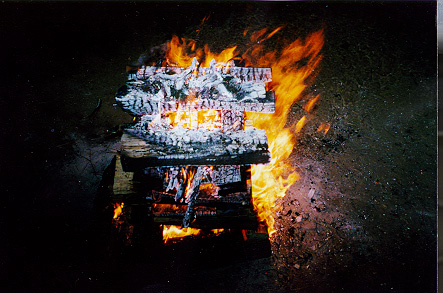
LOG CABIN-COUNCIL FIRE
Back to Firecraft Home
LOG CABIN-COUNCIL FIRE
Back to Firecraft Home
If possible use already constructed fire rings. Otherwise, dig down through the organic matter completely to the next soil horizon. This will enable the ground and vegetation to recover when you leave and replace the sod. Use rocks if available as a break to keep embers from jumping. A good method employed by the Scouts is to lay a bed of rocks with the fire being built on top to protect the soil. Do not place directly under a tree or within 15 feet of ground brush. Use common sense. A big fire is nonsense to have for a true woodsman. Utilize rocks, natural breaks, proper fire types, and other methods to maximize heat. Never leave a lit firesite unattended. Be knowledgeable of the area you are camping in. Know the dry season. Be READY to use proper firfighting techniques should you need to.
There are several ways to start fires. One must simply remember the requirements of "life" for a fire. 1)Fuel 2)Oxygen 3)Heat or Ignition
Special lighting methods include:
Potassium Permanganate added to Glycerin-> KMnO4 + glycerin = fire. Make a small funnel with paper, add the KMnO4 and then seven to ten minutes before you want your fire to spontaneously light, add the glycerin. This is great for council fires.
Another method is to use DOT 4 Brake fluid and add this over pure chlorine tablets or powder in the same manner. This method takes less time to react.
You can also use:
Bow and Drill
Two D cell Flashlight batteries, connect wire to the + and - ends, and touch it to 0000 super fine steel wool mixed with cotten. It helps to prepare this before hand, by inter-twining the two materials, then let stand outside in a small container filled with lighter fluid. Leave uncovered. The fluid will dry and its chemical residues will enhance your materials lighting ability. Place these items in your firebuilding or survival kit.
Cupric Chloride for blue/green flames.
1
Look in Adventures in Camping
Check also the Boy Scouts of America Handbook2
Look in Adventures in Camping
FM-21-76 SURVIVAL / US Army
The Boy Scouts of America Handbook
3
a. One match
b. Flint and steel
c. Bow and drill
d. Metal Match
e. Magnifying glass
Look in Adventures in Camping
FM-21-76 SURVIVAL / US Army
The Boy Scouts of America Handbook
4
Look in Adventures in Camping
FM-21-76 SURVIVAL / US Army
The Boy Scouts of America Handbook
5
Look in Adventures in Camping
FM-21-76 SURVIVAL / US Army
The Boy Scouts of America Handbook
6
Look in Adventures in Camping
The Boy Scouts of America Handbook
7
a. Home
b. Woods
c. Open field
Look in Adventures in Camping
The Boy Scouts of America Handbook
8
Look in Adventures in Camping
FM-21-76 SURVIVAL / US Army
The Boy Scouts of America Handbook
9
Look in Adventures in Camping
(metal match)
Look in Adventures in Camping Chapter 14, (survival)
FM-21-76 SURVIVAL / US Army
The Boy Scouts of America Handbook
High school chemistry text books regarding oxidation reagents
Flint and Steel10
Look in Adventures in Camping
FM-21-76 SURVIVAL / US Army
The Boy Scouts of America Handbook
High school chemistry text books regarding flame tests
11